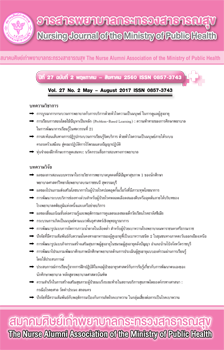ปัจจัยที่มีความสัมพันธ์กับความมั่นคงทางอาหารของผู้สูงอายุที่ เป็นเบาหวานชนิด 2 ในชุมชนทางภาคตะวันออกเฉียงเหนือ*
Main Article Content
Abstract
บทคัดย่อ
การศึกษาเชิงวิเคราะห์ความสัมพันธ์ในครั้งนี้มีวัตถุประสงค์เพื่อ 1) ศึกษาความมั่นคงทางอาหาร 2) ศึกษาความสัมพันธ์ของปัจจัยส่วนบุคคลและครอบครัว ปัจจัยระหว่างบุคคลและสิ่งแวดล้อมภายนอก ปัจจัยด้านเวลากับการเปลี่ยนแปลงกับความมั่นคงทางอาหารและ 3) ศึกษาความสัมพันธ์ของความมั่นคง ทางอาหารกับภาวะสุขภาพของผู้สูงอายุที่เป็นเบาหวานชนิดที่ 2 ในชุมชนทางภาคตะวันออกเฉียงเหนือ ตัวอย่างคือ ผู้สูงอายุที่เป็นเบาหวานชนิดที่ 2 จำนวน 213 คน เลือกแบบสะดวกตามเกณฑ์คัดเข้า เก็บรวบรวมข้อมูลโดยการสัมภาษณ์แบบมีโครงสร้าง วิเคราะห์ข้อมูลด้วยสถิติบรรยาย สถิติสหสัมพันธ์ของ สเปียร์แมน สถิติสหสัมพันธ์แบบพอยท์ไบซีเรียลและสถิติสหสัมพันธ์แบบไบซีเรียล
ผลการศึกษาพบว่า ใน 1 ปีที่ผ่านมา ผู้สูงอายุมีปัญหาความมั่นคงทางอาหาร คือ ด้านความวิตกกังวลเรื่องอาหารมากที่สุด (ร้อยละ 98.1) ปัจจัยส่วนบุคคลและครอบครัวมีความสัมพันธ์ กับความมั่นคงทางอาหารรายด้าน ได้แก่ รายได้ของผู้สูงอายุกับความวิตกกังวลเรื่องอาหาร (rs=-.142, p<.05) รายได้ของครอบครัวกับปริมาณอาหาร (rs=.151, p<.05) และรายได้ของครอบครัวกับคุณภาพอาหาร (rs=.185, p<.01) ปัจจัยระหว่างบุคคลและสิ่งแวดล้อมภายนอก (แรงสนับสนุนทางสังคม) มีความสัมพันธ์กับความมั่นคงทางอาหารทั้งโดยรวม (rs=-.231, p<.01) และรายด้านคือ ด้านปริมาณอาหาร (rs=-.325, p<.001) ด้านคุณภาพอาหาร (rs=-.151, p<.05) ด้านความปลอดภัยของอาหาร (rs=.147, p<.05) ด้านความวิตกกังวล เรื่องอาหาร (rs=-.572, p<.001) การรับรู้ภาวะสุขภาพโดยรวมมีความสัมพันธ์กับความมั่นคงทางอาหาร โดยรวม (rs=-.289, p<.001) และรายด้านคือ ด้านปริมาณอาหาร (rs=-.379, p<.001) ด้านความปลอดภัยของอาหาร (rs=-.197, p<.01) และคุณภาพชีวิตมีความสัมพันธ์กับความมั่นคงทางอาหารรายด้านคือด้านคุณภาพอาหาร (rs = .232, p<.01) ด้านความปลอดภัยของอาหาร (rs=-.182, p<.01) และด้านความวิตกกังวลเรื่องอาหาร (rs=-.160, p<.05) ผลการศึกษาครั้งนี้ มีข้อเสนอแนะต่อพยาบาลเวชปฏิบัติชุมชนในการติดตามและให้ การสนับสนุนผู้สูงอายุที่เป็นเบาหวานชนิดที่2 โดยเฉพาะผู้ที่มีรายได้ครอบครัวน้อยและให้การสนับสนุน ทางสังคมเพื่อให้ผู้สูงอายุมีความมั่นคงทางอาหาร การรับรู้ภาวะสุขภาพและคุณภาพชีวิตที่ดี
Factors Related to Food Security of Older Persons with
Type 2 Diabetes in a Community of Northeast Thailand*
Oranit Jantasen**
Noppawan Piaseu***
Suchinda Jarupat Maruo***
Abstract
Abstract
This correlational study aimed to1) describe food security of older persons with type 2 diabetes mellitus; 2) examine the relationships between the microsystem and mesosystem factors, the exosystem, and the chronosystem and food security; and 3) examine the relationship between food security and health status of older persons with type 2 diabetes mellitus in a community in the Northeast Thailand. A sample of 213 older persons with type 2 diabetes mellitus was recruited by convenience sampling method using inclusion criteria. Data were collected by structured interviews and analyzed using Spearman Rank Correlation, Point Biserial Correlation and Biserial Correlation.
The results showed that the highest category of food security problem expressed by the sample in the past year was concern about food (98.1%). The microsystem and mesosystem factors associated with food security dimensions were as follows: personal income was related to the concern about food (rs=-.142, p<.05); family income was related to the food quantity (rs=.151, p<.05). The exosystem factor, social support, was related to overall food security (rs=-.231, p<.01), food quantity (rs=-.325, p<.001), food quality (rs=-.151, p<.01), food safety (rs=.147, p<.05), and concern about food (rs=-.572, p<.001).
Perceived overall health status was related to overall food security (rs=-.289, p<.001) and food security dimensions including food quantity (rs=-.379, p<.001), and food safety (rs=-.197, p<.01). Quality of life was related to food security dimensions including food quality (rs=.232, p<.01), food safety (rs=-.182, p<.01), and concern about food (rs=-.160, p<.05).
The results of this study recommend that community nurse practitioners monitor and provide support to older persons with type 2 diabetes mellitus particularly those with low family income to ensure their food security, perceived health status, and quality of life.
*Thesis of master degree community nurse practitioner. Ramathibodi School of nursing. Faculty of Medicine, Ramathibodi Hospital. Mahidol University
** Master of Nursing Science (Community Health Nurse Practitioner), Ramathibodi School of nursing, Faculty of Medicine Ramathibodi Hospital, Mahidol University
***Ramathibodi School of Nursing, Faculty of Medicine Ramathibodi Hospital, Mahidol University
Article Details
บทความและรายงานวิจัยในวารสารพยาบาลกระทรวงสาธารณสุข เป็นความคิดเห็นของ ผู้เขียน มิใช่ของคณะผู้จัดทำ และมิใช่ความรับผิดชอบของสมาคมศิษย์เก่าพยาบาลกระทรวงสาธารณสุข ซึ่งสามารถนำไปอ้างอิงได้
